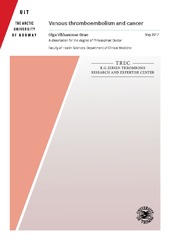| dc.contributor.advisor | Hansen, John-Bjarne | |
| dc.contributor.author | Gran, Olga Vikhammer | |
| dc.date.accessioned | 2017-07-28T11:17:27Z | |
| dc.date.available | 2017-07-28T11:17:27Z | |
| dc.date.issued | 2017-06-27 | |
| dc.description.abstract | Venous thromboembolism (VTE) is a collective term for deep vein thrombosis and pulmonary embolism. VTE is a common cause of mortality and morbidity in patients with cancer, and may also be the first sign of an underlying malignancy. The first aim of this thesis was to investigate the risk of incident and recurrent VTE in active cancer compared to a cancer-free reference population and to explore the influence of genetic risk factors on cancer-related VTE. Secondly, we aimed to investigate the association between plasma D-dimer levels at VTE and the subsequent risk of cancer.
All four papers in this thesis utilize the Tromsø Study. The first survey of the Tromsø Study was conducted in 1974 and, thus far, seven surveys have been completed. Our study populations were recruited from the Tromsø 4 and 6 surveys for Paper I, and Tromsø 1 to 6 surveys for Papers III and IV. Participants were followed from 1994, when the VTE registry was established in Tromsø, throughout 2012. Paper II was based on the Scandinavian Thrombosis and Cancer (STAC) cohort, which comprises individual data from the Tromsø 4 survey, the second Nord-Trøndelag Health Study (HUNT2) and the Danish Diet, Cancer and Health (DCH) Study. Validated VTE events and cancer diagnoses were registered from inclusion (1993 to 1997) to the end of follow-up (2007 to 2012).
We found a joint effect between two single nucleotide polymorphisms (SNPs) in the F5 gene (F5 rs6025 (Factor V Leiden) and F5 rs4524) and active cancer on the risk of VTE. The incidence of cancer-related VTE increased considerably in the six months following a cancer diagnosis, and especially so in patients with risk alleles at these SNPs.
Further, cancer-related factors consistently demonstrated a strong influence on incident and recurrent VTE. In traditional analysis, the risk of VTE was highest in the first 6 months after cancer diagnosis and the risk declined markedly thereafter. However, when mortality was taken into account, the risk of VTE was equal in the 6 months before and 6 months after a cancer diagnosis, which suggests that cancer itself is a major contributor to the VTE risk. The risk of VTE by cancer sites was greatly influenced by mortality and the time since cancer diagnosis. We found that patients with an occult cancer-related incident VTE had a higher rate of VTE recurrence than those with overt cancer and those without cancer. Patients with occult cancer-related incident VTE who experienced a VTE recurrence more often had prothrombotic and advanced cancers at the time of cancer diagnosis. The majority of VTE recurrences were not related to cancer treatment as they occurred prior to cancer diagnosis.
Finally, we found that plasma D-dimer levels above 5000 ng/ml at incident VTE were associated with an increased risk of subsequent cancer at one and two years. Patients with higher D-dimer levels at incident VTE had more advanced cancers at the time of diagnosis and mortality was greater among these patients. | en_US |
| dc.description.abstract | Venøs tromboembolisme (VTE) er fellesbetegnelsen for dyp venetrombose og lungeemboli. VTE er en vanlig årsak til morbiditet og mortalitet blant kreftpasienter, og kan i tillegg være et tidlig tegn på underliggende malignitet. Formålet med denne avhandlingen var å undersøke risikoen for førstegangs- og residiverende VTE ved aktiv kreftsykdom sammenlignet med en kreftfri referansepopulasjon, og å undersøke hvordan genetiske risikofaktorer påvirker VTE. Videre ville vi undersøke assosiasjonen mellom plasma D-dimer ved VTE diagnose og påfølgende risiko for kreft.
Alle fire artikler i denne avhandlingen benytter data fra Tromsøundersøkelsen. Den første Tromsøundersøkelsen ble gjennomført i 1974 og så langt har 7 undersøkelser blitt utført. Studiepopulasjonen i artikkel I ble rekruttert fra Tromsø 4 og 6. For artikkel III og IV benyttet vi undersøkelsene 1 til 6. Deltakere ble fulgt fra 1994, da VTE-registeret ble etablert, ut desember 2012. Artikkel II er basert på «the Scandinavian Thrombosis and Cancer (STAC)» kohorten, som inkluderer individuelle data fra Tromsø 4, den andre Helseundersøkelsen i Nord-Trøndelag (HUNT2) og den danske «Diet, Cancer and Health» (DCH) studien. Validerte VTE- og kreftdiagnoser ble registrert fra inklusjonsperioden (1993 -1997), til og med oppfølgingsperioden (2007-2012).
To genetiske varianter (single nucleotide polymorphism, SNP) i FV genet (F5 rs6025 (Faktor V Leiden) og F5 rs4524) i kombinasjon med aktiv kreftsykdom, hadde en synergistisk effekt på risikoen for VTE. Insidensen av kreftrelatert VTE økte betydelig i de første 6 månedene etter en kreftdiagnose, og spesielt blant pasienter med risikoalleler av disse SNPene. I tillegg hadde kreftrelaterte faktorer som type kreft og metastasegrad en sterk innvirf2010kning på risikoen for førstegangs- og residiverende VTE. Ved bruk av tradisjonelle analysemetoder fant vi at risikoen for VTE var høyest de første 6 månedene etter kreftdiagnosen. Men, når vi tok høyde for mortaliteten blant disse pasientene, var risikoen for VTE den samme i perioden 6 måneder før og 6 måneder etter kreftdiagnosen, hvilket antyder at kreftsykdommen alene har stor innvirkning på VTE-risikoen. Videre var risikoen for VTE ved ulike krefttyper sterkt påvirket av mortalitet og tid siden kreftdiagnosen. Vi oppdaget at VTE pasienter med okkult kreft hadde høyere forekomst av residiverende VTE enn både de med diagnostisert kreftsykdom og kreftfrie pasienter. Pasienter med okkult kreft som fikk residiverende VTE hadde oftere protrombotisk og avansert kreftsykdom når kreftdiagnosen ble stilt. De fleste VTE residivene var ikke relatert til kreftbehandling da de inntraff før kreftsykdommen ble oppdaget.
Til slutt fant vi at plasma D-dimer nivå over 5000 ng/ml ved førstegangs VTE var assosiert med økt risiko for kreft både ett og to år etter VTE en VTE hendelse. Pasienter med høyt D-dimer nivå ved førstegangs VTE hadde i større grad avansert kreftsykdom ved diagnosetidspunktet, og mortaliteten var høyere blant disse pasientene. | en_US |
| dc.description.doctoraltype | ph.d. | en_US |
| dc.description.popularabstract | Venous thromboembolism (VTE) is a frequent and potentially fatal complication in cancer. It is essential to identify cancer patients at high risk of VTE in order to distinguish those who would most benefit from thromboprophylaxis. In this thesis, the relationship between VTE and cancer was investigated in cohorts with participants from the Tromsø Study and the Scandinavian Thrombosis and Cancer (STAC), which is made up of three large population-based cohorts from Norway and Denmark. We found a joint effect between two single nucleotide polymorphism in the F5 gene (F5 rs6025 (Factor V Leiden) and F5 rs4524) and active cancer on the risk of VTE. Cancer-related factors consistently demonstrated to be strong contributors on the risk of incident and recurrent VTE. Our findings that the VTE risk is equal in the six months before and six months after a cancer diagnosis, that late-stage cancer at diagnosis is a common feature in occult and overt-cancer related VTE, and that the majority of occult-cancer related incident recurrences occur before a cancer diagnosis reinforce this assumption. Further, VTE can also be the first sign of an underlying cancer. We found that plasma D-dimer levels above 5000 ng/ml at incident VTE were associated with a higher risk of subsequent cancer at one and two years. | en_US |
| dc.description.sponsorship | Stiftelsen Kristian Gerhard Jebsen,
UiT - Norges Arktiske Universitet | en_US |
| dc.description | The paper II of this thesis is not available in Munin. <br>
Paper II: Blix, K., Gran, O. V., Severinsen, M. T., Cannegieter, S., Jensvoll, H., Overvad, K., Hammerstrøm, J., Tjønneland, A., Næss, I. A., Brækkan, S. K., Rosendaal, F. R., Kristensen, S. R., Hansen, J. B.: «Impact of time since diagnosis and mortality rate on cancer-associated venous
thromboembolism in a general population – the Scandinavian Thrombosis and Cancer
(STAC) cohort». (Manuscript). | en_US |
| dc.identifier.uri | https://hdl.handle.net/10037/11258 | |
| dc.language.iso | eng | en_US |
| dc.publisher | UiT The Arctic University of Norway | en_US |
| dc.publisher | UiT Norges arktiske universitet | en_US |
| dc.rights.accessRights | openAccess | en_US |
| dc.rights.holder | Copyright 2017 The Author(s) | |
| dc.rights.uri | https://creativecommons.org/licenses/by-nc-sa/3.0 | en_US |
| dc.rights | Attribution-NonCommercial-ShareAlike 3.0 Unported (CC BY-NC-SA 3.0) | en_US |
| dc.subject | VDP::Medical disciplines: 700::Clinical medical disciplines: 750::Hematology: 775 | en_US |
| dc.subject | VDP::Medisinske Fag: 700::Klinisk medisinske fag: 750::Hematologi: 775 | en_US |
| dc.subject | The Tromsø Study | |
| dc.subject | Tromsøundersøkelsen | |
| dc.title | Venous thromboembolism and cancer | en_US |
| dc.type | Doctoral thesis | en_US |
| dc.type | Doktorgradsavhandling | en_US |


 English
English norsk
norsk



